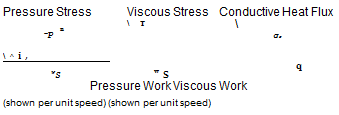Surface forces, work rate, heating
 |
 |
The fluid is subjected to stress, or force per unit area, acting on every area element of the surface of the control volume. This is broken down into the pressure stress —pn along and opposite to the surface-normal n, and the viscous stress vector т which can have any orientation, as shown in Figure 1.4.
Figure 1.4: Flow-field quantities p, p, VV together with a surface normal vector П define pressure and viscous stress forces acting on each surface point, with corresponding work contributions wS. Flow-Field quantities k, VT define the conductive heat flux vector q at each surface point, with corresponding normal flux component qS. These are all associated with molecular motion.
The pressure stress is isotropic (same magnitude for any П direction), and is the only stress which can be present in a fluid which either has a spatially-uniform velocity, or is in solid-body rotation, as shown in Figure 1.5. In contrast, the viscous stress is the result of the fluid’s deformation rate, or equivalently the strain rate, also shown in Figure 1.5. More precisely, the viscous stress vector т acting on a surface with unit normal П is given by
т = r ■ П (1.21)
where r is the viscous stress tensor, which is symmetric and therefore has six independent components.
 |
|
Uniform flow Solid-body rotation Simple shear flow
Figure 1.5: Viscous stresses occur in a fluid element which is subjected to a strain rate, as in the simple shear flow case.
Common gases and liquids like air and water are Newtonian fluids, for which the r components are proportional (via the viscosity factor) to the corresponding strain rate tensor components, which in turn are
 |
||
constructed from the nine independent components of the velocity gradient matrix VV (see Batchelor [2]).
The contribution of the velocity divergence а (also called the dilatation rate) is subtracted to make the stress tensor have zero trace, Txx+Tyy+Tzz = 0. This zero-trace assumption is known as Stokes’s Hypothesis [3].
The pressure and viscous forces will also exert a work rate wS on the moving fluid
wS = (— pn + t • n) • V = – pV • n + V • r • n (1.24)
which has units of power per unit area. Unlike the power per unit volume rate wV given by (1.20), this wS is not an unambiguous field quantity since it is associated with some arbitrary surface whose orientation is specified by its normal vector n.
 |
|||
Fourier’s Law of heat conduction assumes that the conductive heat flux vector q is proportional to the heat conductivity k and the temperature gradient. This is analogous to the Newtonian viscous stress model, and is valid for most common solids and fluids, including air. For perfect gases the q vector can also be given via the static enthalpy gradient and viscosity via the Prandtl number. Its component qS along the normal of some arbitrary surface is the heat rate per unit area flowing through the surface.













